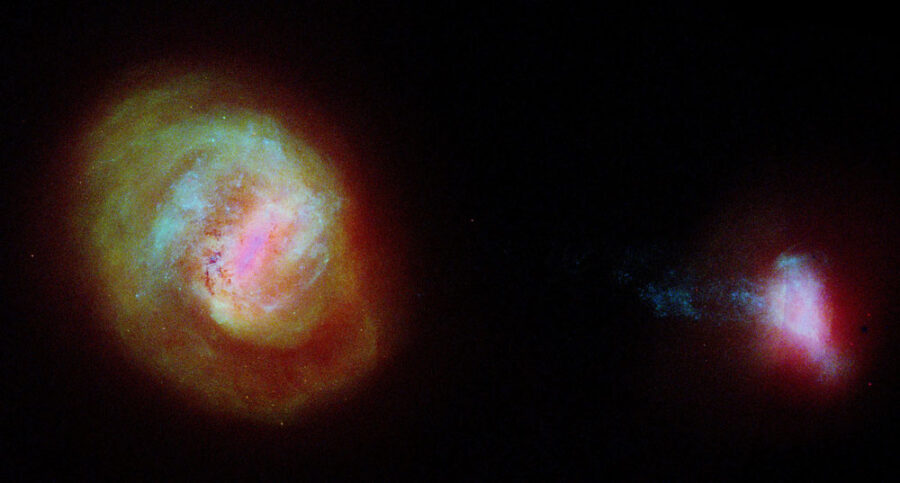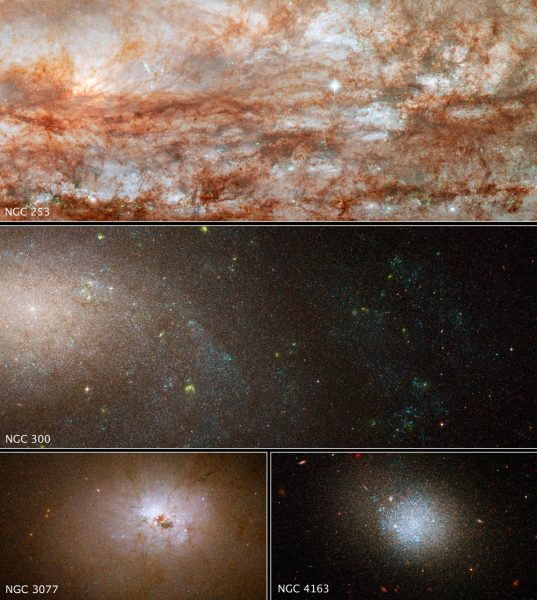A study of 36 dwarf galaxies within a volume of space spanning 13 million light-years show they all have remarkably similar histories despite the vast distances between them.
Astronomers have seen the Milky Way’s profound effect on its entourage of smaller galaxies. Our similarly sized sister galaxy, Andromeda, likewise affects the evolution of its assembly of dwarf satellites. But a study of dozens of nearby galaxies shows that the impact of the Milky Way and Andromeda galaxies may extend much farther than previously thought.

ESA / Gaia / DPAC / CC BY-SA 3.0 IGO; Acknowledgement: L. Chemin; X. Luri et al (2020)
Charlotte Olsen (Rutgers University) and her colleagues homed in on 36 galaxies that were part of the ACS Nearby Galaxy Survey Treasury (ANGST), where ACS is the Advanced Camera for Surveys aboard the Hubble Space Telescope. These galaxies are “nearby” only in the cosmic sense of the word — they span a volume of space 13 million light-years across. For comparison, the Milky Way’s disk spans roughly 100,000 light-years and even its dark matter halo only extends out to some 1 million light-years.
Yet, according to the analysis by Olsen’s team, to appear in the Astrophysical Journal (preprint available here), all 36 dwarf galaxies appear to have remarkably similar star formation histories despite the vast distances between them.
Olsen and her colleagues measured the galaxies’ star formation histories in two ways. The first involves measuring the brightness and colors of individual stars, but astronomers can only use this method for galaxies close enough to make out those stars. For more distant galaxies, whose stars blend together in the telescope, astronomers typically resort to measuring the amount of light emitted in different wavelength bands. For example, galaxies with lots of new stars will emit more ultraviolet light, while those with older stars will emit more infrared.

NASA / ESA / J. Dalcanton and B. Williams (University of Washington)
While the dwarfs are all nearby, using the two methods allows Olsen’s team to compare them and look for discrepancies in investigations of galaxies near and far. Fortunately, the two methods match. Marla Geha (Yale University), who was not involved in the study, says the result is “a lovely demonstration that two commonly used methods to estimate the star formation histories agree.”
Synchronized Star Formation
Regardless which method Olsen’s team used, the astronomers found a curiously common trend: After a period of quietude, the dwarfs began firing up their star-forming factories about 3 billion years ago, and they’ve maintained that activity since then.
Dwarfs orbiting a bigger galaxy will often follow its lead, going quiet when it does and forming stars when it does, Olsen explains. But the galaxies her team examined span a wider space, outside the halo of the Milky Way’s influence. “We still need to find what is driving this behavior, and how much of the rest of the universe is behaving this way, before we can learn what is behind it,” Olsen says.
“We know that the Milky Way and Andromeda can fully quench star formation in galaxies out to nearly 6.5 million light-years away,” Geha says. “While this result includes galaxies at twice this distance, I can still imagine the Milky Way/Andromeda having some influence. It will be super interesting to see if similar results are seen in numerical simulations.”
 0
0
Comments
You must be logged in to post a comment.